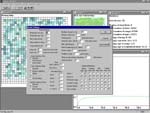
Environment:
Habitat patchiness (often caused by human disturbance) can decrease the number of song tutors a young bird has to learn from.Behavioral strategies:
Habitat structure can also determine who birds learn from as well. Various barriers to movement, such as open fields for species who prefer wooded areas, can create complex patterns of song sharing at the local level.
Mortality rates vary with geographic location, capacity of habitat to sustain individuals, preditor densities, bird age, etc. Does mortality rate affect 1) what songs a bird learns, and 2) how many neighbors.
Timing of dispersal is a crucial event for young birds, and can have a direct effect on how many songs they share with their territorial neighbors. If birds leave their natal area after they have memorized their songs, they will likely not share song types with any neighboring birds. Likewise, if birds have the ability to learn later in life, they can drop songs that are different from those in the area they have settled and add "local" song types.Pre-existing cultural conditions:
Song learning strategies have a direct impact on sharing: if birds prefer to learn shared songs, then song sharing should generally increase in the population. However, birds may use other learning strategies, such as learning from the most successful male, or learning from as many neighbors as possible, or even randomly selecting songs. Without a model, it is hard to make predictions about what effects these strategies have on sharing.
The songs that already exist in a neighborhood are the only material, besides improvisation, that young birds have to use for their own song learning. This recursive connection to previous generations can create complex patterns of sharing that, in turn, affect successive generations and can only be seen in a generational model such as the one I am developing.
The
Program:
Sim-Songbird simulates the song
dynamics of a neighborhood of songbirds over time. Simulated birds hatch,
disperse, memorize songs from tutor birds, select their repertoire, establish
territories, and tutor new birds. Important variables such as when birds learn,
who they learn from, environmental factors, etc are adjustable as parameters.
Over years, a pattern of song sharing develops that can be compared with real
bird populations. The screen picture below is from the model in its current state of
development. Although not complete, this model still generates patterns of song
sharing that look like natural conditions and which can be manipulated by
changing parameters.
